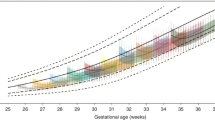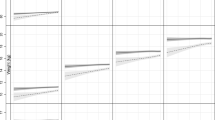Abstract
Objective
To evaluate associations between pre-pregnancy body mass index (BMI), gestational weight gain (GWG), and postnatal growth in preterm infants.
Design
A cohort study of 14,962 births < 32 weeks’ gestation. We used multivariable linear regression to assess associations between maternal BMI or GWG (models stratified by BMI) and infant postnatal growth, defined as the difference between discharge and birth weight Z-scores based on Fenton or INTERGROWTH-21st growth charts.
Result
For BMI, obesity class 2 was positively associated with postnatal growth using the Fenton chart. Using INTERGROWTH-21st, inadequate or excessive GWG in women with underweight or obesity class 3 were associated with postnatal growth in different directions. Excessive GWG in women with normal weight was negatively associated with postnatal growth defined by Fenton.
Conclusion
Some categories of BMI and GWG were modestly associated with postnatal growth in preterm infants. Results were inconsistent within and between the INTERGROWTH-21st standard and Fenton growth reference.
This is a preview of subscription content, access via your institution
Access options
Subscribe to this journal
Receive 12 print issues and online access
$259.00 per year
only $21.58 per issue
Buy this article
- Purchase on Springer Link
- Instant access to full article PDF
Prices may be subject to local taxes which are calculated during checkout
Similar content being viewed by others
References
Nour NM. Premature delivery and the millennium development goal. Rev Obstet Gynecol. 2012;5:100–5.
Parkinson JRC, Hyde MJ, Gale C, Santhakumaran S, Modi N. Preterm birth and the metabolic syndrome in adult life: a systematic review and meta-analysis. Pediatrics. 2013;131:e1240–e1263. https://doi.org/10.1542/peds.2012-2177.
Sutton PS, Darmstadt GL. Preterm birth and neurodevelopment: a review of outcomes and recommendations for early identification and cost-effective interventions. J Trop Pediatr. 2013;59:258–65. https://doi.org/10.1093/tropej/fmt012.
Ong KK, Kennedy K, Castañeda-Gutiérrez E, Forsyth S, Godfrey KM, Koletzko B, et al. Postnatal growth in preterm infants and later health outcomes: a systematic review. Acta Paediatr. 2015;104:974–86. https://doi.org/10.1111/apa.13128.
Chehade H, Simeoni U, Guignard JP, Boubred F. Preterm birth: long term cardiovascular and renal consequences. Curr Pediatr Rev. 2018;14:219–26. https://doi.org/10.2174/1573396314666180813121652.
De Boo HA, Harding JE. The developmental origins of adult disease (Barker) hypothesis. Aust N Z J Obstet Gynaecol. 2006;46:4–14. https://doi.org/10.1111/j.1479-828X.2006.00506.x.
Johnson MJ, Wootton SA, Leaf AA, Jackson AA. Preterm birth and body composition at term equivalent age: a systematic review and meta-analysis. Pediatrics. 2012;130:e640–e649. https://doi.org/10.1542/peds.2011-3379.
Ong KK. Catch-up growth in small for gestational age babies: good or bad? Curr Opin Endocrinol Diabetes Obes. 2007;14:30–34. https://doi.org/10.1097/MED.0b013e328013da6c.
Institute of Medicine. Weight gain during pregnancy: reexamining the guidelines. In: Rasmussen KM, Yaktine AL editors. Washington, DC: The National Academies Press; 2009.
Pigatti Silva F, Souza RT, Cecatti JG, et al. Role of body mass index and gestational weight gain on preterm birth and adverse perinatal outcomes. Sci Rep. 2019;9:13093. https://doi.org/10.1038/s41598-019-49704-x.
Goldstein RF, Abell SK, Ranasinha S, Misso M, Boyle JA, Black MH, et al. Association of gestational weight gain with maternal and infant outcomes: a systematic review and meta-analysis. JAMA. 2017;317:2207–25. https://doi.org/10.1001/jama.2017.3635.
Santos S, Voerman E, Amiano P, Barros H, Beilin LJ, Bergstrom A, et al. Impact of maternal body mass index and gestational weight gain on pregnancy complications: an individual participant data meta-analysis of European, North American and Australian cohorts. BJOG 2019;126:984–95. https://doi.org/10.1111/1471-0528.15661.
Bodnar LM, Siminerio LL, Himes KP, Hutcheon JA, Lash TL, Parisi SM, et al. Maternal obesity and gestational weight gain are risk factors for infant death. Obesity. 2016;24:490–8. https://doi.org/10.1002/oby.21335.
Yu Z, Han S, Zhu J, Sun X, Ji C, Guo X. Pre-pregnancy body mass index in relation to infant birth weight and offspring overweight/obesity: a systematic review and meta-analysis. PLoS ONE. 2013;8. https://doi.org/10.1371/journal.pone.0061627.
Mamun AA, Mannan M, Doi SAR. Gestational weight gain in relation to offspring obesity over the life course: a systematic review and bias-adjusted meta-analysis: gestational weight gain and offspring obesity. Obes Rev. 2014;15:338–47. https://doi.org/10.1111/obr.12132.
Fuemmeler BF, Wang L, Iversen ES, Maguire R, Murphy SK, Hoyo C. Association between prepregnancy body mass index and gestational weight gain with size, tempo, and velocity of infant growth: analysis of the newborn epigenetic study cohort. Child Obes. 2016;12:210–8. https://doi.org/10.1089/chi.2015.0253.
Li C, Zeng L, Wang D, Dang S, Chen T, Watson V, et al. Effect of maternal pre-pregnancy BMI and weekly gestational weight gain on the development of infants. Nutr J. 2019;18:6. https://doi.org/10.1186/s12937-019-0432-8.
Deierlein AL, Siega-Riz AM, Adair LS, Herring AH. Effects of pre-pregnancy body mass index and gestational weight gain on infant anthropometric outcomes. J Pediatr. 2011;158:221–6. https://doi.org/10.1016/j.jpeds.2010.08.008.
Remme WJ, Swedberg K, Task Force for the Diagnosis and Treatment of Chronic Heart Failure, European Society of Cardiology. Guidelines for the diagnosis and treatment of chronic heart failure. Eur Heart J. 2001;22:1527–60.
Centers for Disease Control and Prevention. User guide to the 2016 natality public use file, 2017. ftp://ftp.cdc.gov/pub/Health_Statistics/NCHS/Dataset_Documentation/DVS/natality/UserGuide2016.pdf. Accessed 17 Nov 2019.
Hutcheon JA, Platt RW, Abrams B, Himes KP, Simhan HN, Bodnar LM. A weight-gain for-gestational-age z score chart for the assessment of maternal weight gain in pregnancy. Am J Clin Nutr. 2013;97:1062–7.
Hutcheon JA, Bodnar LM. Good practices for observational studies of maternal weight and weight gain in pregnancy. Paediatr Perinat Epidemiol. 2018;32:152–60.
Bodnar LM, Hutcheon JA, Parisi SM, Pugh SJ, Abrams B. Comparison of gestational weight gain z-scores and traditional weight gain measures in relation to perinatal outcomes. Paediatr Perinat Epidemiol. 2015;29:11–21.
Hutcheon JA, Platt RW, Abrams B, Himes KP, Simhan HN, Bodnar LM. Pregnancy weight gain charts for obese and overweight women. Obesity. 2015;23:532–5.
Villar J, Giuliani F, Bhutta ZA, Bertino E, Ohuma EO, Ismail LC, et al. Postnatal growth standards for preterm infants: the preterm postnatal follow-up study of the INTERGROWTH-21st project. Lancet Glob Health. 2015;3:e681–e691. https://doi.org/10.1016/S2214-109X(15)00163-1.
Ong KK, Loos RJ. Rapid infancy weight gain and subsequent obesity: systematic reviews and hopeful suggestions. Acta Paediatr. 2006;95:904–8. https://doi.org/10.1080/08035250600719754.
Fenton TR, Kim JH. A systematic review and meta-analysis to revise the Fenton growth chart for preterm infants. BMC Pediatr. 2013;13:59. https://doi.org/10.1186/1471-2431-13-59.
Tuzun F, Yucesoy E, Baysal B, Kumral A, Duman N, Ozkan H. Comparison of INTERGROWTH-21 and Fenton growth standards to assess size at birth and extrauterine growth in very preterm infants. J Matern Fetal Neonatal Med. 2018;31:2252–7. https://doi.org/10.1080/14767058.2017.1339270.
Anderson NH, Sadler LC, McKinlay CJD, McCowan LME. INTERGROWTH-21st vs customized birthweight standards for identification of perinatal mortality and morbidity. Am J Obstet Gynecol. 2016;214:509.e1–509.e7. https://doi.org/10.1016/j.ajog.2015.10.931.
Kozuki N, Katz J, Christian P, Lee AC, Liu L, Silveira MF, et al. Comparison of US birth weight references and the international fetal and newborn growth consortium for the 21st century standard. JAMA Pediatr. 2015;169:e151438. https://doi.org/10.1001/jamapediatrics.2015.1438.
Subhan FB, Colman I, McCargar L, Bell RC, APrON Study Team. Higher pre-pregnancy BMI and excessive gestational weight gain are risk factors for rapid weight gain in infants. Matern Child Health J. 2017;21:1396–407. https://doi.org/10.1007/s10995-016-2246-z.
Franz AR, Pohlandt F, Bode H, Mihatsch WA, Sander S, Kron M, et al. Intrauterine, early neonatal, and postdischarge growth and neurodevelopmental outcome at 5.4 years in extremely preterm infants after intensive neonatal nutritional support. Pediatrics. 2009;123:e101–e109. https://doi.org/10.1542/peds.2008-1352.
Taine M, Charles MA, Beltrand J, Rozé JC, Léger J, Botton J, et al. Early postnatal growth and neurodevelopment in children born moderately preterm or small for gestational age at term: a systematic review. Paediatr Perinat Epidemiol. 2018;32:268–80. https://doi.org/10.1111/ppe.12468.
Darendeliler F, Coban A, Baş F, Bundak R, Dişçi R, Sükür M, et al. Catch-up growth inappropriate- or small-for-gestational-age preterm infants. Turk J Pediatr. 2008;50:207–13.
Brandt I, Sticker EJ, Gausche R, Lentze MJ. Catch-up growth of supine length/length of very low birth weight, small for gestational age preterm infants to adulthood. J Pediatr. 2005;147:662–8. https://doi.org/10.1016/j.jpeds.2005.06.034.
Singhal A. Long-term adverse effects of early growth acceleration or catch-up growth. Ann Nutr Metab. 2017;70:236–40. https://doi.org/10.1159/000464302.
Kerkhof GF, Willemsen RH, Leunissen RW, Breukhoven PE, Hokken-Koelega AC. Health profile of young adults born preterm: negative effects of rapid weight gain in early life. J Clin Endocrinol Metab. 2012;97:4498–506. https://doi.org/10.1210/jc.2012-1716.
Li N, Liu E, Guo J, Pan L, Li B, Wang P, et al. Maternal prepregnancy body mass index and gestational weight gain on offspring overweight in early infancy. PLoS ONE. 2013;8:e77809. https://doi.org/10.1371/journal.pone.0077809. Published 2013 Oct 11
Vahratian A. Prevalence of overweight and obesity among women of childbearing age: results from the 2002 National Survey of Family Growth. Matern Child Health J. 2009;13:268–73. https://doi.org/10.1007/s10995-008-0340-6.
Brodowski L, Büter W, Kohls F, Hillemanns P, von Kaisenberg C, Dammann O. Maternal overweight, inflammation and neurological consequences for the preterm child: results of the ELGAN study. Geburtshilfe Frauenheilkd. 2019;79:1176–82. https://doi.org/10.1055/a-0960-0939.
Stotland NE, Cheng YW, Hopkins LM, Caughey AB. Gestational weight gain and adverse neonatal outcome among term infants. Obstetr Gynecol. 2006;108:635–43. https://doi.org/10.1097/01.AOG.0000228960.16678.bd.
Watanabe H, Inoue K, Doi M, Matsumoto M, Ogasawara K, Fukuoka H, et al. Risk factors for term small for gestational age infants in women with low prepregnancy body mass index: risk factors for SGA in infants. J Obstet Gynaecol Res. 2010;36:506–12. https://doi.org/10.1111/j.1447-0756.2010.01170.x.
Cho WK, Suh BK. Catch-up growth and catch-up fat in children born small for gestational age. Korean J Pediatr. 2016;59:1–7. https://doi.org/10.3345/kjp.2016.59.1.1.
Gaillard R. Maternal obesity during pregnancy and cardiovascular development and disease in the offspring. Eur J Epidemiol. 2015;30:1141–52. https://doi.org/10.1007/s10654-015-0085-7.
Wood CT, Linthavong O, Perrin EM, Leviton A, Allred EN, Kuban K, et al. Antecedents of obesity among children born extremely preterm. Pediatrics. 2018;142:e20180519. https://doi.org/10.1542/peds.2018-0519.
Hack M, Schluchter M, Margevicius S, Andreias L, Taylor HG, Cuttler L. Trajectory and correlates of growth of extremely-low-birthweight adolescents. Pediatr Res. 2014;75:358–66.
Pringle KG, Lee YQ, Weatherall L, Keogh L, Diehm C, Roberts CT, et al. Influence of maternal adiposity, preterm birth and birth weight centiles on early childhood obesity in an Indigenous Australian pregnancy-through-to-early-childhood cohort study. J Dev Orig Health Dis. 2019;10:39–47. https://doi.org/10.1017/S2040174418000302.
Villar J, Giuliani F, Fenton TR, Ohuma EO, Ismail LC, Kennedy SH. INTERGROWTH-21st very preterm size at birth reference charts. Lancet. 2016;387:844–5. https://doi.org/10.1016/S0140-6736(16)00384-6.
Headen I, Cohen AK, Mujahid M, Abrams B. The accuracy of self-reported pregnancy-related weight: a systematic review. Obes Rev. 2017;18:350–69. https://doi.org/10.1111/obr.12486.
Author information
Authors and Affiliations
Corresponding author
Ethics declarations
Conflict of interest
The authors declare no competing interests.
Additional information
Publisher’s note Springer Nature remains neutral with regard to jurisdictional claims in published maps and institutional affiliations.
Supplementary information
Rights and permissions
About this article
Cite this article
Joaquino, S.M., Lee, H.C. & Abrams, B. Pre-pregnancy body mass index, gestational weight gain and postnatal growth in preterm infants. J Perinatol 41, 1825–1834 (2021). https://doi.org/10.1038/s41372-021-01087-6
Received:
Revised:
Accepted:
Published:
Issue Date:
DOI: https://doi.org/10.1038/s41372-021-01087-6



